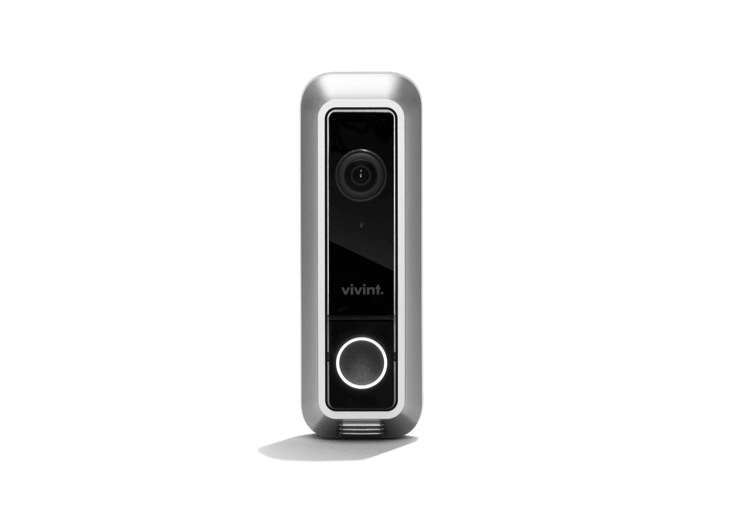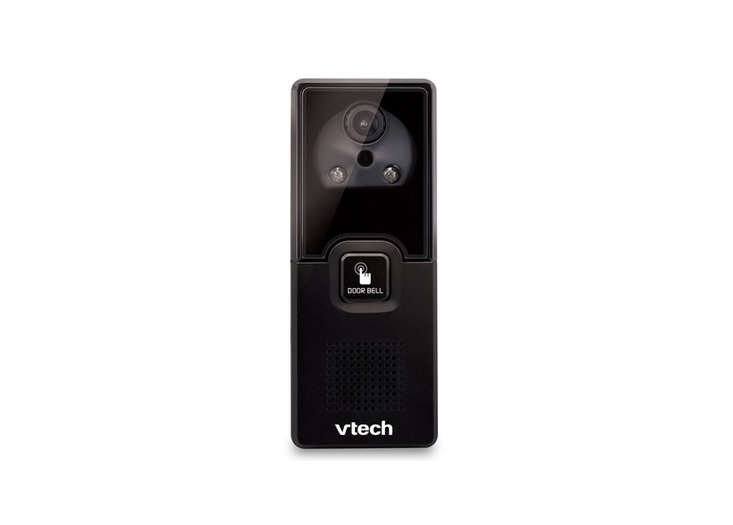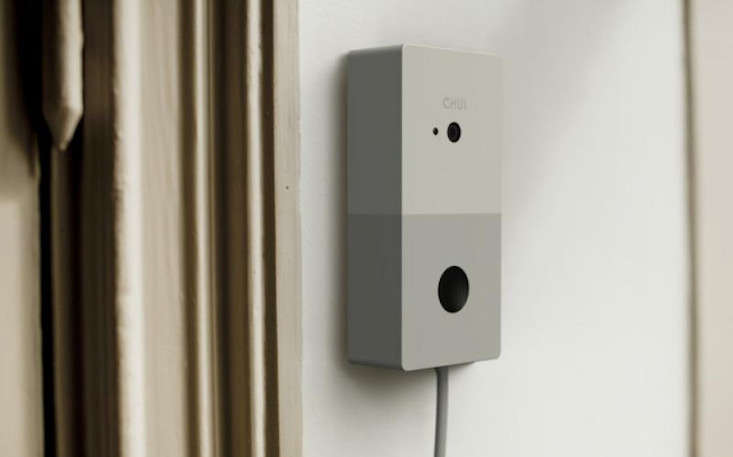We’re not saying you’re lazy. Who wouldn’t want to see who’s at the door without even getting up off the couch? And maybe even be able to unlock the door so guests can walk right in?
If that sounds good, then maybe a smart doorbell is in your future. What does “smart” mean in this case? It means the doorbell is connected to a live video feed, so you can check your smartphone to see who just rang. You might be sprawled comfortably on your couch—or you might be on the other side of the globe.

Above: A Vivint Doorbell Camera is $199.
Why would I want a smart doorbell?
Once it’s connected to your Wi-Fi network, the device sends a view of your front porch to your smartphone (or tablet) and lets you speak to visitors, even if you’re not home. People with limited mobility will especially appreciate the convenience. You can see who’s there before you go to open the door, or leave the door closed if it’s a solicitor. If you’re at work, you can check that your kid has gotten back from school safely.
Smart doorbells can increase home security. You can use the intercom to make would-be intruders think there’s someone home when there isn’t. You can keep an eye out for delivered packages. If a break-in or theft happens, the stored video might help you or the police identify the culprits.
Above: A Ring Video Doorbell Pro is $249.
Are all smart doorbells alike?
Most offer some or all of the following functions:
- A video camera that shows (and in most cases records) the action outside your door.
- An app to interact with the system.
- Two-way audio so you can converse with whoever’s at the door.
- A motion detector. Alerted by someone approaching, it activates the video camera and sends a push notification to your phone (sometimes even a call). Some devices let you make adjustments so the motion detector isn’t set off by passing cars and the like.
- Night vision, so you don’t need to leave an outdoor light on for the device to capture good video.
How do I decide which one is right for me?
Start by reading up on what’s available, searching reputable websites where the various contenders are compared and contrasted. Be aware that this technology is changing all the time. A smart doorbell whose low-definition camera got poor reviews last year may have a newer HD version. Make sure you’re reading about current models (and don’t trust all the reviews on Amazon).
You’ll soon learn how the devices differ. Some can be installed wirelessly, others hardwired so there’s no need to worry about batteries losing power. Some store doorbell videos on a memory card, others on the Cloud.
Not all smart doorbells work with both iOS and Android devices. Some can be linked to other smart home devices, like those made by Nest and August.
Since most smart doorbells are wider than traditional doorbells, you’ll need to check the dimensions to make sure the casing won’t overhang your doorframe—especially if your doorframe is narrow.
Above: From August, a Smart Doorbell Cam (R) is part of a system that includes a Smart Lock and Smart Keyboard.
What does a smart doorbell cost?
The popular, best-reviewed models come in the $200 range. Some charge extra to store video footage, while others provide that service for free or as part of a security package.
Will I have to change my current set-up to add a smart doorbell?
Generally, you’ll be able to keep the same buzzer or chimes (or clapper). But if you’ve already upgraded to a digital doorbell, you may need an adapter to make it work with your doorbell cam. So before you buy, you should know whether your existing doorbell is digital or mechanical.
Above: Upgrading your buzzer? Consider a Door Bell Clapper, “an electrical ringing mechanism from the 1960s, with a formidable electro-technical capacity inside a black thermoset housing,” says retailer Manufactum. “Both activate a 4-centimeter-long clapper made of nickel-plated brass inside an 8-centimeter-deep horn-shaped gong made of nickel-plated sheet steel.” It’s €64.
Can I install a smart doorbell myself?
That depends on how handy you are—it can be more complicated than installing a mechanical doorbell. Manufacturers’ websites provide videos and/or step-by-step instructions showing you how to hardwire the device into your existing connection. Some devices require you to hire an expert.
Which smart doorbells should I consider?
Here are some of the top contenders right now:
SkyBell Video Doorbell
Above: A SkyBell HD Wi-Fi Video Doorbell is $199.
The SkyBell HD is the top pick at CNET and The Wirecutter, earning high points for its excellent 1080p HD video camera, easy-to use app, and assortment of features including full color night vision.
If you have an existing hardwired doorbell, the SkyBell is easily installed by simply connecting the wires from your old doorbell so the device can be powered by your house current. Then download the app to your smartphone and connect the doorbell to the app.
LED bulbs provide light to help you see who’s at the door after dark. You can turn the motion detector on or off, but you can’t control its sensitivity. SkyBell offers free Cloud storage of your videos.
You can link a SkyBell HD to several smart-home platforms, including Nest and Amazon Echo. The doorbell comes in silver or aged bronze, but the plastic housing may not please all buyers.
Nice touch: Thanks to its theft guarantee, Skybell will replace the doorbell if it’s stolen.
Ring Video Doorbell
Above: A Ring Video Doorbell Pro is $249.
As with the Skybell, you must have an existing hardwired doorbell to install this one. The earlier Ring Video Doorbell (still available at $199) had a built-in rechargeable battery that bulked up the device considerably. The newer, hardwired Pro is much slimmer, and comes with four interchangeable faceplates in different finishes. It offers high-quality 1080p video and a motion detector that you can customize by designating actual shapes, such as your front walkway or mailbox.
The night vision camera provides clear video when it’s dark outside. Storing your videos on the Cloud will cost an extra $30 per year.
If your home has a SmartThings or Wink hub, you can link the Ring doorbell to it.
Ring also will replace the device for free if it’s stolen.
August Doorbell Cam
Above: An August Doorbell Cam is $199.
Fortune magazine rated this the best doorbell, and its handsome design gets top nods from other consumer sites. The latest version has motion-detection and video-recording abilities, as well as Cloud storage ($50 per year).
Besides its style, the August Doorbell Cam offers great HD video—as long as the available light is adequate. Unlike the Skybell and Ring, the August has no LED lights. That’s fine if you keep your porch light on all night, or your entrance is illuminated by street lamps. If not, night-time videos won’t be of great quality.
If you’ve installed an August smart lock on your door, you can use the same app to unlock the door. Let’s say you’re at work when your trusted Fed-Ex guy arrives: You can let him in to leave your package inside—and watch to make sure he closes the door behind him. (You can also thank him for his help).
The August Doorbell Cam comes in two colors, silver and dark gray. At 2.9 inches in diameter, it might not fit on a narrow doorframe.
Vivint Doorbell Camera
Above: A Vivint Doorbell Camera is $199.
If money’s no object, consider Vivint. The doorbell itself is around the same price as others ($199), but it only comes as part of a five-year smart home-monitoring package that requires you to buy other devices and pay a $60 per month fee. For that you get a sleek small device, professional installation, and all the expected features.
Are there any inexpensive options?
Above: Yes, but you won’t get all the bells and whistles. A VTech IS741 Accessory Audio/Video Doorbell Camera $49.95, and has a video cam that lets you screen visitors who ring the doorbell, but you’ll need a VTech IS7121 series phone to operate it.
What’s on the horizon?
Above: A Chui Face Recognition Doorbell lets you program familiar faces into the device. It will then open the door when it recognizes you or your family members, while barring strangers. So far only a beta model is available from this crowd-funded startup. As with most smart devices, you’d be smart to wait till all the bugs are out.
N.B.: See more of our Hardware 101 design guides for Gate Latches and Gate Hinges.






















Have a Question or Comment About This Post?
Join the conversation (0)